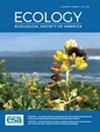Contrasting demographic processes underlie uphill shifts in a desert ecosystem
IF 4.4
2区 环境科学与生态学
Q1 ECOLOGY
引用次数: 0
Abstract
Climate change is projected to cause extensive plant range shifts, and, in many cases such shifts already are underway. Most long‐term studies of range shifts measure emergent changes in species distributions but not the underlying demographic patterns that shape them. To better understand species' elevational range shifts and their underlying demographic processes, we use the powerful approach of rephotography, comparing historical (1978–1982) and modern (2015–2016) photographs taken along a 1000‐m elevational gradient in the Colorado Desert of Southern California. This approach allowed us to track demographic outcomes for 4263 individual plants of 11 long‐lived, perennial species over the past ~36 years. All species showed an upward shift in mean elevation (average = 45 m), consistent with observed increasing temperature and severe drought in the region. We found that varying demographic processes underlaid these elevational shifts, with some species showing higher recruitment and some showing higher survival with increasing elevation. Species with faster life‐history rates (higher background recruitment and mortality rates) underwent larger elevational shifts. Our findings emphasize the importance of demography and life history in shaping range shift responses and future community composition, as well as the sensitivity of desert systems to climate change despite the typical “slow motion” population dynamics of perennial desert plants.沙漠生态系统上坡变化的人口变化过程截然不同
据预测,气候变化将导致广泛的植物分布区转移,而且在许多情况下,这种转移已经在进行中。大多数关于分布范围变化的长期研究都是测量物种分布的新变化,而不是形成这些变化的潜在人口模式。为了更好地了解物种的海拔范围变化及其潜在的人口过程,我们采用了重新摄影这一强大的方法,比较了南加州科罗拉多沙漠沿 1000 米海拔梯度拍摄的历史照片(1978-1982 年)和现代照片(2015-2016 年)。通过这种方法,我们可以追踪过去约 36 年间 11 种多年生长寿植物 4263 株个体的人口统计结果。所有物种的平均海拔都在上升(平均 = 45 米),这与观测到的该地区气温升高和严重干旱的情况一致。我们发现,随着海拔的升高,这些海拔变化的背后隐藏着不同的人口统计过程,有些物种表现出更高的新陈代谢率,有些物种则表现出更高的存活率。生命史速率较快(背景招募率和死亡率较高)的物种经历了更大的海拔变化。我们的发现强调了人口统计和生命史在影响范围迁移反应和未来群落组成方面的重要性,以及沙漠系统对气候变化的敏感性,尽管多年生沙漠植物的种群动态是典型的 "慢动作"。
本文章由计算机程序翻译,如有差异,请以英文原文为准。
求助全文
约1分钟内获得全文
求助全文
来源期刊

Ecology
环境科学-生态学
CiteScore
8.30
自引率
2.10%
发文量
332
审稿时长
3 months
期刊介绍:
Ecology publishes articles that report on the basic elements of ecological research. Emphasis is placed on concise, clear articles documenting important ecological phenomena. The journal publishes a broad array of research that includes a rapidly expanding envelope of subject matter, techniques, approaches, and concepts: paleoecology through present-day phenomena; evolutionary, population, physiological, community, and ecosystem ecology, as well as biogeochemistry; inclusive of descriptive, comparative, experimental, mathematical, statistical, and interdisciplinary approaches.
 求助内容:
求助内容: 应助结果提醒方式:
应助结果提醒方式:


